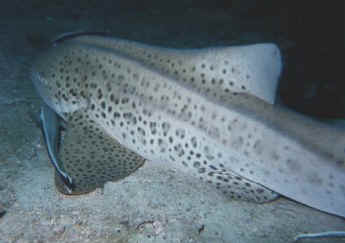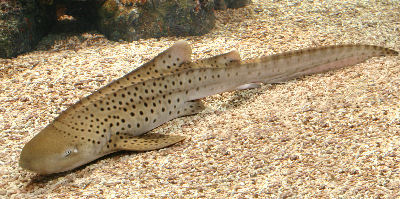True to its name as a youngster, the Zebra Shark has a striped pattern, but as an adult it is spotted. So much for the “zebra”, …and no wonder it is also called the Leopard Shark!
� Although the Zebra Shark is also referred to as a Leopard Shark, it is not the same animal as the more commonly known Leopard Shark,
Triakis semifasciatus
, frequently offered in the aquarium industry. You can learn about the more common aquarium species here:
.
The young Zebra Shark has a dark brown to blackish background with narrow yellow bars and yellow spots. This bold coloration will change and the banding will fade as it ages. As an adult it will be a creamy or yellowish-brown with dark brown spots. There have even been a few occasions of an adult developing into an albino coloring.
 Photo Courtesy: Jim Sheil | Many pictures of the Zebra Shark, like in this photo, will show a discfish or a little cleaner fish near the mouth or on the nose. The discfish seen here is a Remora Shark. Notice the two ridges running down the back. These develop in the adult shark and extend all the way down to the caudal fin. The coloring of this shark starts to change and the ridge begins to develop when they have reached about 27″ (70 cm). Another striking characteristic of this fish is the long cauldal (tail) fin, it is almost as long as the sharks body! |
The Zebra Shark is a bottom feeder that is found in the Great Barrier Reef and the Coral Sea. It is a sluggish and slow swimming fish living in tropical waters. Unaggressive when approached, the Zebra Shark is considered harmless by divers.
For more Information on keeping marine fish see:
Guide to a Happy, Healthy Marine Aquarium
- Kingdom: Animalia
- Phylum: Actiniform
- Class: Elasmobranchii
- Order: Orectolobiformes
- Family: Stegostomatidae
- Genus: Stegostoma
- Species: fasciatum
- Beginner Fish – Saltwater fish for beginners
- Community Fish – Peaceful Saltwater fish
- Hardy Fish – Hardy Saltwater fish
Maintenance difficulty:
Though the Zebra Shark will readily acclimate to an aquarium and is easy to keep, it gets much too large for most home aquariums. They are best kept by experts with the ability to provide a very large enclosure.
Maintenance:
Feed all kinds of large meaty foods like small pieces of fish, squid, shrimp. They will also eat clams, mussels, and snails. They are nocturnal feeders, resting during the day and getting active at night.
Habitat: Natural geographic location:
The Zebra Shark is found from East Africa and the Red Sea to Australia and New Caledonia also recently from Tonga. Usually found on sandy bottoms on or near coral reefs, though they have also been recorded to enter freshwater.
Foods:
Natural foods include gastropod and bivalve molluscs with smaller amounts of crabs, shrimp, and small fish.
Social Behaviors:
This fish can be kept with other fish and is usually no problem even with smaller fish that could be eaten. They usually only try to eat fish that are either dying or distressed.
Sex: Sexual differences:
The medial edges of the male’s pelvic fins are modified to form claspers. The claspers are tubelike organs designed to deliver sperm into the female’s reproductive tract. As the males grow older the claspers become more pronounced. The females do not have these.
Light: Recommended light levels:
Breeding/Reproduction:
An oviparous egglayer, the Zebra Shark has been known to breed in large public aquariums. It lays eggs that are 6.5 inches (17 cm) in length. The eggs are dark colored and have tufts of hair attached which serve to anchor them to the bottom. The eggs will hatch in about 170 days. The young are 8 – 10 inches (20 – 26 cm) in length when they hatch.
Temperature:
Length/Diameter of fish:
Zebra Shark adults can grow to 11.5 feet (354 cm) but are more common in the 5-8 foot (150-250 cm) range.
Minimum Tank Length/Size:
A minimum 400 gallon aquarium is recommended.
Water Movement: Weak, Moderate, Strong
Water Region: Top, Middle, Bottom
Spends time at all water levels.
